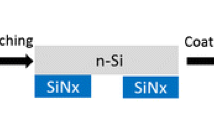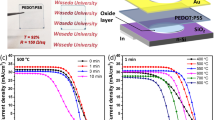Abstract
The Poly-Si/SiOx stack passivation structure incorporate doped polycrystalline silicon (Poly-Si) and tunneling silicon oxide (SiOx) thin films allows for majority-carrier transport as well as block minority carriers and suppress recombination, and thus enable very high efficiency. Up to now the Poly-Si/SiOx stack passivation have been a widespread research topic for photovoltaic researchers, but most of the works are only focused on n-type doped structures and the rear side polished surface of the solar cells. In order to apply the Poly-Si/SiOx stack structure to the front textured surface and p+ emitter region to obtain high-efficiency double-sided passivated contact solar cells and Si-based tandem cells in the future. In this work, passivation properties of Poly-Si/SiOx stack capped with SiNx:H layer are discussed based on different crystalline silicon surface morphologies, dopant types, doping profiles and thickness of Poly-Si layer. With proper doping process control, an excellent implied open-circuit voltage (iVoc) of 706 mV with a saturation current density (J0) value of 12 fA/cm2 has been obtained for the boron-doped Poly-Si/SiOx stack capped with SiNx:H based on the textured surface, and an iVoc of 736 mV with a J0 value of 2 fA/cm2 has been acquired for the phosphorus-doped Poly-Si/SiOx stack capped with SiNx:H based on the acid polished surface. The results show that the polished surface and thinner Poly-Si layer are helpful for passivation. For the doped Poly-Si/SiOx stack structure, the doping source will penetrate the tunneling SiOx layer into the silicon bulk to form a certain penetration depth on the surface of the silicon substrate. In order to acquire the high iVoc (low J0) value, a penetration depth of around 160 nm is needed to the phosphorus-doped Poly-Si/SiOx stack, while a penetration depth of less than 25 nm is required for boron-doped Poly-Si/SiOx stack. In addition, there is a linear relationship between the Rsheet value and the reciprocal value of the Poly-Si (n+) layer thickness.
Similar content being viewed by others
Data Availability
Not applicable.
References
Aberle AG (2000) Surface passivation of crystalline silicon solar cells: a review. Pro Photovolt: Res Appl 8:473–487
Schmidt J et al (2019) Surface passivation of crystalline silicon solar cells: past, present and future. Sol Energy Mater Sol Cells 187:39–54
Blakers A (2019) Development of the PERC solar cell. IEEE J Photovolt 9:629–635
Daming C et al (2020) 24.58% total area efficiency of screen-printed, large area industrial silicon solar cells with the tunnel oxide passivated contacts (i-TOPCon) design. Sol Energy Mater Sol Cells 206(1–8):110258
Martin G et al (2020) Solar cell efficiency tables (version 57). Prog Photovolt Res Appl 29:3–15
Richter A et al (2017) n-Type Si solar cells with passivating electron contact: Identifying sources for efficiency limitations by wafer thickness and resistivity variation. Sol Energy Mater Sol Cells 206(1–10):S092702481730257X
Xinbo Y et al (2021) Solution-doped polysilicon passivating contacts for silicon solar cells. ACS Appl Mater Interfaces 13:8455–8460
Haase F et al (2018) Laser contact openings for local poly-Si-metal contacts enabling 26.1% efficient POLO-IBC solar cells. Sol Energy Mater Sol Cells 186:184–193
Ran C et al (2021) 24.58% efficient commercial n-type silicon solar cells with hydrogenation. Prog Photovolt Res Appl 29:1–6
Martin AG et al (2021) Solar cell efficiency tables (version 58). Prog Photovolt Res Appl 29:657–667
Feldmann F et al (2014) Passivated rear contacts for high-efficiency n-type Si solar cells providing high interface passivation quality and excellent transport characteristics. Sol Energy Mater Sol Cells 120:270–274
Verma M, Mishra GP (2021) Effect of 1-D silver grated electrode on wafer-based TOPCon c-Si solar cell. Silicon 14:1–10
Yifeng C et al (2019) Mass production of industrial tunnel oxide passivated contacts (i-TOPCon) silicon solar cells with average efficiency over 23% and modules over 345 W. Prog Photovolt Res Appl 27:827–834
Peter J. Cousins et al (2010) Generation 3: Improved performance at lower cost. 2010 35th IEEE Photovoltaic Specialists Conference 275–278
Guanchao X et al (2019) 25% cell efficiency with integration of passivating contact technology and interdigitated back contact structure on 6”wafers. IEEE 46th Photovoltaic Specialists Conference 1452–1455
Feldmann F et al (2014) Carrier-selective contacts for Si solar cells. Appl Phys Lett 104:181105
Peibst Robby et al (2018) Building blocks for industrial, screen-printed double-side contacted POLO cells with highly transparent ZnO: Al layers. IEEE Journal of Photovoltaics 8:1–7
Aditi J et al (2021) Design, optimization, and in-depth understanding of front and rear junction double-side passivated contacts solar cells. IEEE 47th Photovoltaic Specialists Conference
Reiter S et al (2016) Parasitic absorption in polycrystalline Si-layers for carrier-selective front junctions. Energy Procedia 92:199–204
Campbell P, Green MA (1987) Light trapping properties of pyramidally textured surfaces. J Appl Phys 62(1):243–249
Frigge S et al (2016) Implementation of n+ and p+ poly junctions on front and rear side of double-side contacted industrial silicon solar cells. 32nd European Photovoltaic Solar Energy Conference and Exhibition 323–327
Stodolny MK et al (2018) Novel schemes of p+ poly-Si hydrogenation implemented in industrial 6 bifacial front-and-rear passivating contacts solar cells. 35th European Photovoltaic Solar Energy Conference and Exhibition 414–417
Shewchun J, Singh R, Green MA (1977) Theory of metal-insulator-semiconductor solar cells. J Appl Phys 48:765–770
Liang W, Weber KJ, Thomson AF (2014) Effective SiNx: H capping layers on 1-nm Al2O3 for p+ surface passivation. IEEE J Photovoltaics 4(6):1405–1412
Kerr MJ (2002) Surface, emitter and bulk recombination in silicon and development of silicon nitride passivated solar cells. Ph.D. dissertation, Aust. Nat. Univ., Canberra, Australia
Juneja S et al (2015) Highly conductive boron doped micro/nanocrystalline silicon thin films deposited by VHF-PECVD for solar cell applications. J Alloy Compd 643:94–99
Juneja S, Kumar S (2022) Boron induced crystallization of silicon on glass: an alternate way to crystallize amorphous silicon films for solar cells. Silicon 14:1–8
Sinton RA, Cuevas A (2000) A quasi-steady-state open-circuit voltage method for solar cell characterization.16th European Photovoltaic Solar Energy Conference 1–5
Cuevas A (1999) The effect of emitter recombination on the effective lifetime of silicon wafers. Sol Energy Mater Sol Cells 57:277–290
Brunkov PN et al (2011) Electrochemical capacitance-voltage profiling of the free-carrier concentration in HEMT heterostructures based on InGaAs/AlGaAs/GaAs compounds. Semiconductors 45:811–817
Blood P (1986) Capacitance-voltage profiling and the characterisation of III-V semiconductors using electrolyte barriers. J Semicond Tech Sci 1:7–27
Feldmann F et al (2019) Studying dopant diffusion from Poly-Si passivating contacts. Sol Energy Mater Sol Cells 200:109978
Römer U et al (2015) Ion implantation for Poly-Si passivated back-junction back-contacted solar cells. IEEE J Photovolt 5:507–514
Kale AS et al (2019) Modifications of textured silicon surface morphology and its effect on Poly-Si/SiOx contact passivation for silicon solar cells. IEEE J Photovolt 9:1513–1521
Stodolny MK, Anker J et al (2017) Material properties of LPCVD processed n-type polysilicon passivating contacts and its application in PERpoly industrial bifacial solar cells. Energy Procedia 124:635–642
Guangtao Y et al (2018) Poly-crystalline silicon-oxide films as carrier-selective passivating contacts for c-Si solar cells. Appl Phys Lett 112:193904
Hollemann C et al (2020) Separating the two polarities of the polo contacts of an 26.1%-efficient IBC solar cell. Sci Rep 10:658
Rohatgi A et al (2017) Fabrication and modeling of high-efficiency front junction N-Type silicon solar cells with tunnel oxide passivating back contact. IEEE J Photovolt 7(5):1236–1243
Shockley W, Read WT (1952) Statistics of the recombinations of holes and electrons. Phys Rev 87(5):835–842
Bonilla RS et al (2017) Dielectric surface passivation for silicon solar cells: A review. Phys Status Solidi A 1700293:1–30
Feldmann F et al (2019) Studying dopant diffusion from Poly-Si passivating contacts. Sol Energy Mater Sol Cells 200:1–6
Lee WC, Hu C (2001) Modeling CMOS tunneling currents through ultrathin gate oxide due to conduction- and valence-band electron and hole tunneling. IEEE Trans Electron Devices 48(7):1366–1373
Acknowledgements
This work is funded by the China State Power Investment Corporation Limited (SPIC).
Author information
Authors and Affiliations
Contributions
All authors contribute to the study conception and design. As the major contributors in writing the manuscript, Tianjie Zhang and Xiaoyong Qu complete the design and implementation of the experimental scheme. Material preparation, data collection and analysis are performed by Yonggang Guo, Dawei Liu, Xiang Wu, Jiaqing Gao and Tao Lin. The first draft of the manuscript is written by Tianjie Zhang and all authors comment on previous versions of the manuscript. All authors read and agree to the published version of the manuscript.
Corresponding author
Ethics declarations
Ethics Approval
Not applicable.
Informed Consent
Not applicable.
Consent to Participate
Not applicable.
Consent for Publication
The authors agree to publish.
Research involving Human Participants and/or Animals
Not applicable.
Competing Interests
The authors declare no competing interests.
Disclosure of Potential Conflicts of Interest
Not applicable.
Additional information
Publisher's Note
Springer Nature remains neutral with regard to jurisdictional claims in published maps and institutional affiliations.
Rights and permissions
Springer Nature or its licensor holds exclusive rights to this article under a publishing agreement with the author(s) or other rightsholder(s); author self-archiving of the accepted manuscript version of this article is solely governed by the terms of such publishing agreement and applicable law.
About this article
Cite this article
Zhang, T., Qu, X., Guo, Y. et al. The Passivation Characteristics of Poly-Si/SiOx Stack for High-Efficiency Silicon Solar Cells. Silicon 15, 1659–1668 (2023). https://doi.org/10.1007/s12633-022-02127-2
Received:
Accepted:
Published:
Issue Date:
DOI: https://doi.org/10.1007/s12633-022-02127-2




